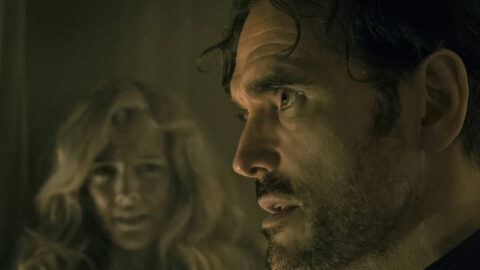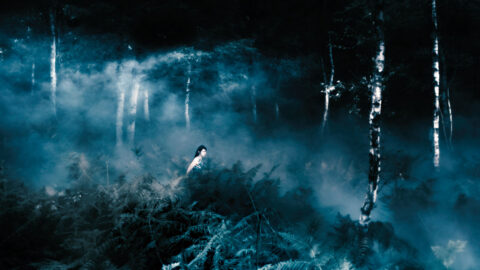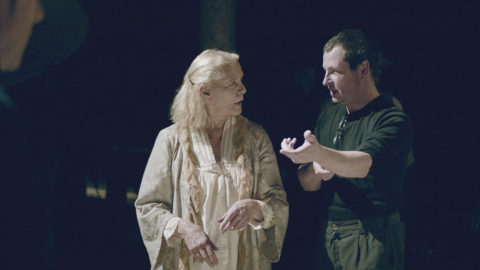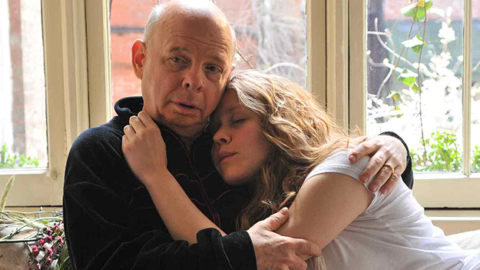Film of the Week: The House That Jack Built
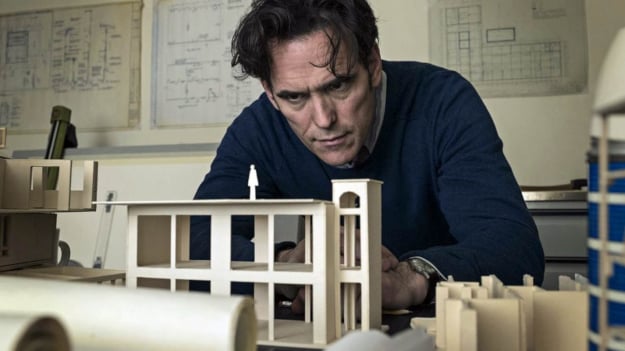
If I were a lazy, cynical copywriter, I’d announce the release of The House That Jack Built with the blurb “Lars von Trier is back! Prepare to be offended!” There’s certainly plenty here to object to: the consistent graphic violence towards women (plus two children, and eventually some men); the knowing, self-referential allusions to Nazism and the use of newsreel footage of the Holocaust; even the flip and casually incongruous use of David Bowie’s “Fame.” If you regularly find that von Trier’s output makes you grind your teeth, book that dentist’s appointment right now: this time, you’ll really need it.
Make no mistake: The House That Jack Built was one of the film events of 2018. At least, it might not have been to you or me, but it certainly was to von Trier, and it was to the Cannes Film Festival, which welcomed the wayward auteur back to the party seven years after declaring him persona non grata because of his remarks about sympathizing with Hitler in his Melancholia press conference. Rehabilitating him was clearly a big deal for the festival: in April, its director Thierry Frémaux commented that his colleague Pierre Lescure “had been working very hard . . . for the removal of the persona non grata status” (what, did they have to extract the microchip they’d implanted in von Trier’s brain as part of the punishment?).
But when The House That Jack Built screened in Cannes out of competition in May, it was quite clear that this was the wrong film at the wrong time, and the wrong film with which to reinstate his red carpet status. At a time when the festival had been under scrutiny following the #MeToo explosion, had introduced a sexual harassment hotline, and had also made a fair fist of ensuring adequate representation of women directors in its official selection (something Venice manifestly failed to do), it seemed perverse to welcome von Trier back with a two-and-a-half-hour film about a man’s tormenting and murdering of women, in which his victims are variously represented as clueless, helpless, and complicit.
The danger with von Trier is that, whatever objection you raise to his films, and their rhetorical strategy, he’s always anticipated your argument, even factored it into the work—like a crafty, smart-arsed captain of a college debating team. It’s the “ah, but…” factor that can make his work fascinating, but just as often makes it infuriating. The idea that the viewer just can’t win with him has become a part of his myth. Years ago in Cannes, a colleague asked me how I’d reviewed Antichrist. I said I’d given it the thumbs down. “Ha!” he laughed. “You’ve fallen into his trap! That’s exactly what he wants—to annoy critics.” So I should have avoided the trap by giving it a positive review? “No, you’d still have fallen into his trap. He wants that too.” What should I have done, then? “Say it was just OK—he’d hate that.”
Von Trier has rarely made films that are just OK. I have sometimes loathed them (Antichrist), sometimes loved them (Melancholia, Europa), generally found them fascinating—his last film, the rambling, knowingly confrontational what-do-women-want? disquisition Nymphomaniac was hardly a pleasure, but it was genuinely ambitious, and troubling and certainly something that one wanted, as a critic, to engage with and pick apart.
But with The House That Jack Built (now shown in the U.S. in a trimmed R-rated version, as well as the full version screened in Cannes), von Trier seems genuinely to have overstepped some limit. He’s gone too far in the extremity of the content, all the more unpleasant because of the tone of drab ruefulness that attends the whole event (as if he’s constantly saying, “I shouldn’t be doing this, should I? And don’t think I don’t hate myself for it”). But he’s also gone too far in making such a bloated, laborious, earnest bore of a film. It’s presented as an extended episodic confession by a murderer named Jack (Matt Dillon)—which is to say that we’re encouraged also to read it as a confession by the director himself. But where the rambling, digressive prolixity of the similarly structured Nymphomaniac was genuinely inventive, here you feel like the wedding guest buttonholed by the Ancient Mariner: you want von Trier to cut to the albatross and leave you the hell alone.
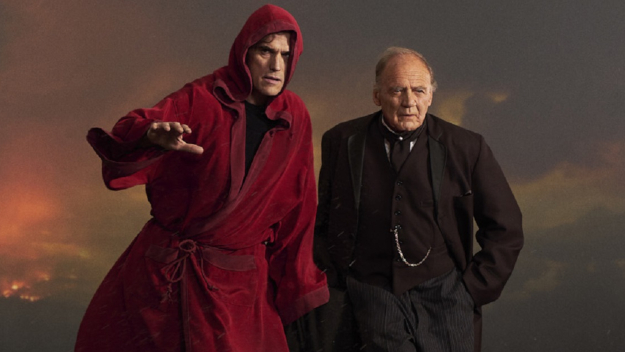
The film begins in darkness with the sound of running water and the voice of Jack beginning his story, which will comprise five randomly chosen incidents from his career of murder. He’s narrating to someone (Bruno Ganz) named “Verge”—and if you guess that this is short for Virgil, you may be able to guess where the film is headed in its spectacular metaphysical epilogue. Verge plays an interlocutor role akin to that of Stellan Skarsgård’s character in Nymphomaniac, feeding Jack cues and undercutting his comments with caustic irony that sometimes speaks for the viewer, who may well be skeptically weary from the get-go: “Just don’t believe you’re going to tell me something I haven’t heard before.”
The vignettes that follow begin with an episode in which Jack brutally kills a woman (Uma Thurman) whose car has broken down, and who is presented as supercilious and condescending, taunting him with playfully reckless comments about him possibly being a serial killer. Then Jack ineptly but, against all odds, successfully talks himself into the house of a woman (Siobhan Fallon Hogan) who’s suspicious at first but then falls for the bait of his offering to double her pension. A third episode shows Jack taking a woman (Sofie Gråbøl) and her two young sons on a hunting trip, on which they become the prey: Jack, and von Trier, then proudly show how morbid they can be with their art, as Jack turns his hand to a spot of macabre taxidermy (which owes a lot to the work of Brit-art shock jocks the Chapman Brothers).
In episode 4, Jack at length insults and torments a young woman he addresses as “Simple” (Riley Keough) before brutalizing her horribly. She’s the only woman actually given a name here, if “Simple” counts—although her real name, which Jack mocks, is Jacqueline (ah, alter ego… we’re perhaps meant to think). Eventually, as if to show that he’s an equal opportunities abuser, Jack terrorizes a group of male victims, although von Trier adds a dig to audience sensibilities by making it a black man that Jack has handcuffed in his van.
What passes for ghoulish humor—the taxidermy, what Jack eventually does to Jacqueline, the farcical cat-and-mouse game with Hogan’s character—is all depressingly familiar, all thought of before by more original masters of the unpleasant such as Hitchcock, Tobe Hooper, or Ed Gein. One of the most depressing things here is the way that von Trier constantly tells us that, yes, he knows there’s nothing much new here, as if reveling in the paucity of his fatigued inspiration. Another story about a serial killer going about his work unsuspected? Didn’t Dexter finish its run five years ago? Von Trier pre-empts us by having Jack say, “I’m not a medical examiner.” Isn’t “Simple,” with her blonde curls, tight jumper, and hot pants, a stereotypical sex object? Well, duh, von Trier tells us, having her unearth a Barbie as she rifles through her possessions. And Verge repeatedly anticipates our objections by reminding Jack what a tawdry, depressing, unoriginal story he’s telling us.
It certainly seems bad timing for von Trier to be telling this story now, not least because it’s so out of keeping with the contemporary climate of feeling about the objectification of and violence towards women (although you suspect that’s precisely why he’s telling it now). But it also just feels out of time: such a movie from von Trier might have seemed a provocative prospect 15 years ago, but now it reeks of staleness. I suppose we’d better prepare ourselves for his zombie movie five years from now.
Of course, it’s possible that von Trier has chosen this overmined terrain because the film’s not really about that at all, but something else entirely: about the pains of being Lars von Trier. His films have always had that self-referential streak, and have often been read as being covertly about him, his abused and tormented heroines as being not so much the director’s symbolic victims as his alter-egos, whose pain he shares and laments by dramatizing it. Well, possibly… but there’s no sense that he in any way empathizes with the women in Jack, not least because he never allows them a scrap of dignity or real personality. The only exception is the Thurman character, who does have a personality, and a highly unlikeable one, to the point where she comes across almost as a devil figure, deliberately tempting Jack to do the evil he resists. “Why is it always the man’s fault?” Jack asks at one point, railing against the “original sin” of sexual culpability he sees as having been forever foisted upon his gender.
And what’s especially objectionable about the hunting episode, apart from the grinding pomposity with which Jack expounds his theory of the hunt, is the fact that Sofie Gråbøl, who proved herself an actress of phenomenal strength and complexity in three series of The Killing, has nothing to do here except look approvingly attentive, then terrified.
OK, it could be argued that through Jack’s violence, von Trier is critiquing his own apparent abuse of his female characters in his fictions; if that’s the case, we either buy into that or we don’t. During Cannes, British critic Caspar Salmon—who noted that he walked out in disgust after the Keough episode—put it very neatly: “Von Trier blithely, or perhaps stupidly, asks us to accept the very terms of his film, and to judge the movie on what he has set out to do—namely, to accept that the violence depicted here… can be a parable for Von Trier’s own abusive behavior towards women, and the way his films have enacted, again and again, the suffering of women. But I do not have to accept those terms; we do not have to collaborate with Von Trier in deeming this a subject. And, incidentally, the abuse of women is a poor metaphor for the abuse of women.”
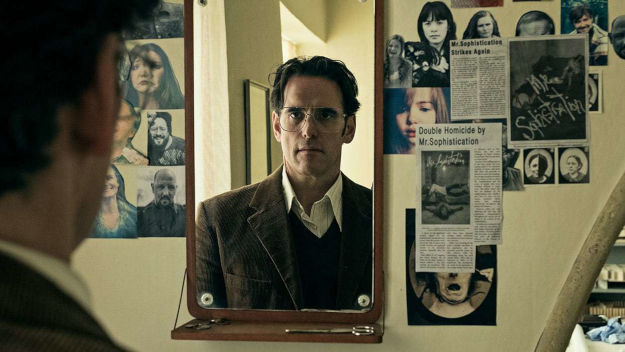
There are many poor, or at least, labored metaphors in the film. One of its conceits is the use of sidebar-like digressions, using interpolated archive and other footage, to illustrate what’s on Jack’s mind. The most inventive is a repeated use of a chalkboard animation, à la William Kentridge, to explain the mechanisms of pleasure and pain in the mind of a compulsive killer. The actual business of building the titular house is illustrated with repeated shots of Jack—an engineer who fancies himself an architect—planning, building, then demolishing prototype houses, presumably just as that von Trier might conceive, develop and abandon ideas for movies. We also get footage of Glenn Gould, to exemplify Jack’s meticulous concern with the creation of great art; a disquisition on the different ways of encouraging decay in grapes, including a phenomena called “noble rot,” to produce dessert wines (Jack is infuriatingly an expert, or semi-expert, on just about everything); and another on the malign brilliance of incorporating an eldritch screeching sound into the design of the Stuka dive bomber.
It’s around this point that Jack muses on the nature of the iconic, pointing out that it is often created by truly evil people, the tyrants of this world. Picking up the very theme that got him kicked out of Cannes, von Trier again invokes Hitler’s architect Albert Speer, and the concept of “noble rot” is juxtaposed by horrific newsreel images of the concentration camps—at which Verge interrupts this fugue: “Stop it! The Antichrist!” It’s shortly after this that von Trier inserts clips from his own films, Antichrist included, to make the argument that great art always has to show us the unacceptable—or perhaps as a sort of mea culpa suggesting that his own art cannot really be great because it’s too bound up with the unacceptable.
But who knows? With von Trier, it’s one thing, and it’s the other. He wants you to hate his films, he wants you to love them. Either way, he’s certainly not contrite in this film, however much he may be wallowing in the thrill of guilt. The House That Jack Built is the most grandiose didja-miss-me? statement ever made in the movies, but here the narcissism—however much it explicitly decries itself throughout as narcissism—simply goes too far. I’ve found myself increasingly getting impatient with films that use the Holocaust as “local color,” as backstory dressing for inconsequential narratives—most recently, Luca Guadagnino’s Suspiria, and I felt the same way about Scorsese’s Shutter Island. But using the Holocaust, however earnestly, in the interest of a self-regarding discussion about the grand themes, and the artist von Trier’s own place in the big picture, seems a gross lapse of taste.
Is there anything one can really like or be impressed by in Jack? Certainly the metaphysical coda, which comes as a bit of a shock, where—for the only time in the film, von Trier and DP Manuel Alberto Claro come up with something extraordinary to look at, however breathlessly kitsch. Otherwise, little here to engage with: the debate feels forced and it flails, the self-referentiality is self-devouring, the polemical sophistication hobbles itself at every step. The provocation is carved in lead.
It must have galled von Trier that this year in Cannes he was upstaged by another provocateur whom he’s usually managed to eclipse at the festival: Gaspar Noé, whose own vision of heaven and hell, joy and torment, Climax, was in turns euphoric and repellent, but was 100 percent cinema. What’s frustrating about The House That Jack Built is that it’s not cinematic enough: too much is verbal discourse and accompanying visual illustration, as though von Trier had lost faith in the power of visual communication. It had this flaw in common with a differently frustrating film, Nuri Bilge Ceylan’s The Wild Pear Tree, an infinitely more intelligent and humane film, but one that again too manifestly yearned to be a great novel.
There’s one moment in The House That Jack Built that is genuinely troubling, but perhaps for other reasons. The Simple sequence, an episode of grindingly cruel irony, aims to show us what a brutally indifferent world we live in. After Simple’s pleas have been ignored by a contemptuous passing policeman, Jack invites her to scream for help, but no one—in the eerily desolate urban wasteland she inhabits—answers, or ever will. It’s a chillingly—perhaps the word is just “depressingly”—bleak moment, as Jack sneers, “In this hell of a town—in this hell of a country—in this hell of a world—no one wants to help.” That’s the film’s despairing cri de coeur in a nutshell. And it’s a message that von Trier may be now taking to heart more than ever. You can be welcomed back to the Croisette with open arms, premiere your grand new statement in a prime slot, even get the mandatory standing ovation in the Palais… and yet despite all this, when it comes down to what you have to say—to the condition of your artistic insight, to the question of how much your vision speaks to changing times—despite all this, what if there’s no one left out there who’s really listening any more?
Jonathan Romney is a contributing editor to Film Comment and writes its Film of the Week column. He is a member of the London Film Critics Circle.



